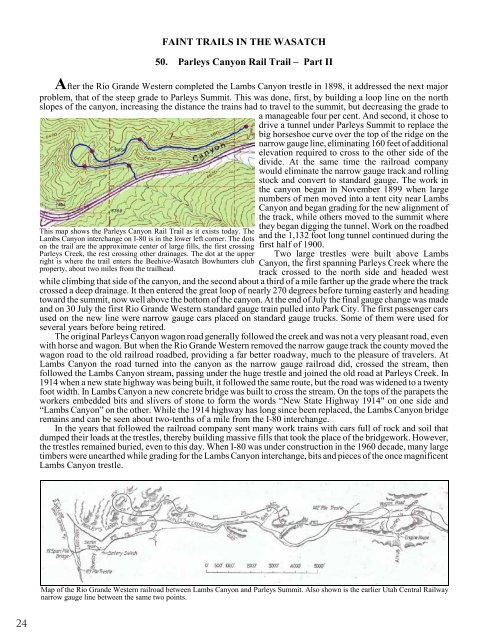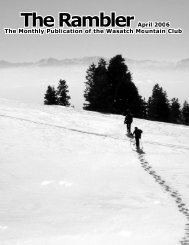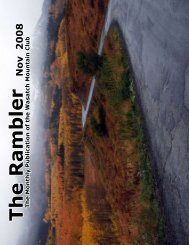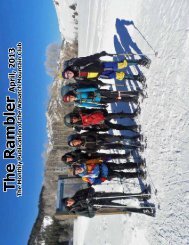Rambler
Mar - Wasatch Mountain Club
Mar - Wasatch Mountain Club
- No tags were found...
Create successful ePaper yourself
Turn your PDF publications into a flip-book with our unique Google optimized e-Paper software.
FAINT TRAILS IN THE WASATCH<br />
50. Parleys Canyon Rail Trail – Part II<br />
After the Rio Grande Western completed the Lambs Canyon trestle in 1898, it addressed the next major<br />
problem, that of the steep grade to Parleys Summit. This was done, first, by building a loop line on the north<br />
slopes of the canyon, increasing the distance the trains had to travel to the summit, but decreasing the grade to<br />
a manageable four per cent. And second, it chose to<br />
drive a tunnel under Parleys Summit to replace the<br />
big horseshoe curve over the top of the ridge on the<br />
narrow gauge line, eliminating 160 feet of additional<br />
elevation required to cross to the other side of the<br />
divide. At the same time the railroad company<br />
would eliminate the narrow gauge track and rolling<br />
stock and convert to standard gauge. The work in<br />
the canyon began in November 1899 when large<br />
numbers of men moved into a tent city near Lambs<br />
Canyon and began grading for the new alignment of<br />
the track, while others moved to the summit where<br />
This map shows the Parleys Canyon Rail Trail as it exists today. The<br />
Lambs Canyon interchange on I-80 is in the lower left corner. The dots<br />
on the trail are the approximate center of large fills, the first crossing<br />
Parleys Creek, the rest crossing other drainages. The dot at the upper<br />
right is where the trail enters the Beehive-Wasatch Bowhunters club<br />
property, about two miles from the trailhead.<br />
they began digging the tunnel. Work on the roadbed<br />
and the 1,132 foot long tunnel continued during the<br />
first half of 1900.<br />
Two large trestles were built above Lambs<br />
Canyon, the first spanning Parleys Creek where the<br />
track crossed to the north side and headed west<br />
while climbing that side of the canyon, and the second about a third of a mile farther up the grade where the track<br />
crossed a deep drainage. It then entered the great loop of nearly 270 degrees before turning easterly and heading<br />
toward the summit, now well above the bottom of the canyon. At the end of July the final gauge change was made<br />
and on 30 July the first Rio Grande Western standard gauge train pulled into Park City. The first passenger cars<br />
used on the new line were narrow gauge cars placed on standard gauge trucks. Some of them were used for<br />
several years before being retired.<br />
The original Parleys Canyon wagon road generally followed the creek and was not a very pleasant road, even<br />
with horse and wagon. But when the Rio Grande Western removed the narrow gauge track the county moved the<br />
wagon road to the old railroad roadbed, providing a far better roadway, much to the pleasure of travelers. At<br />
Lambs Canyon the road turned into the canyon as the narrow gauge railroad did, crossed the stream, then<br />
followed the Lambs Canyon stream, passing under the huge trestle and joined the old road at Parleys Creek. In<br />
1914 when a new state highway was being built, it followed the same route, but the road was widened to a twenty<br />
foot width. In Lambs Canyon a new concrete bridge was built to cross the stream. On the tops of the parapets the<br />
workers embedded bits and slivers of stone to form the words “New State Highway 1914" on one side and<br />
“Lambs Canyon” on the other. While the 1914 highway has long since been replaced, the Lambs Canyon bridge<br />
remains and can be seen about two-tenths of a mile from the I-80 interchange.<br />
In the years that followed the railroad company sent many work trains with cars full of rock and soil that<br />
dumped their loads at the trestles, thereby building massive fills that took the place of the bridgework. However,<br />
the trestles remained buried, even to this day. When I-80 was under construction in the 1960 decade, many large<br />
timbers were unearthed while grading for the Lambs Canyon interchange, bits and pieces of the once magnificent<br />
Lambs Canyon trestle.<br />
Map of the Rio Grande Western railroad between Lambs Canyon and Parleys Summit. Also shown is the earlier Utah Central Railway<br />
narrow gauge line between the same two points.<br />
24
















